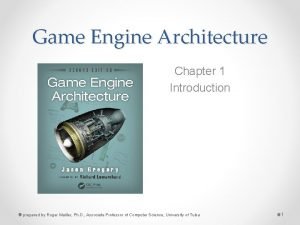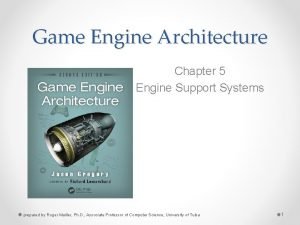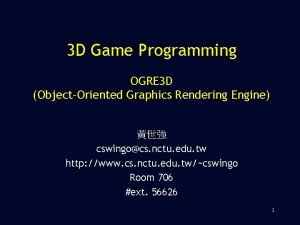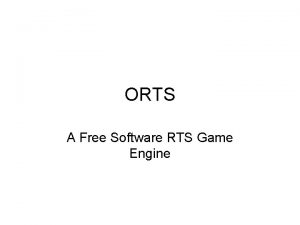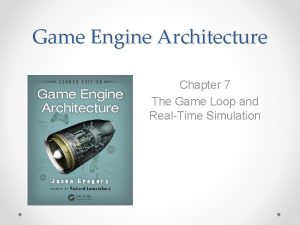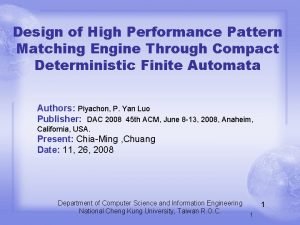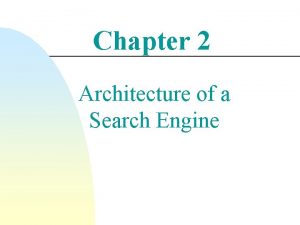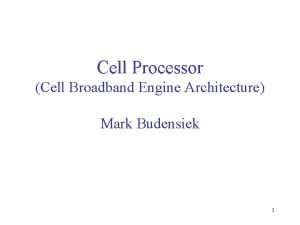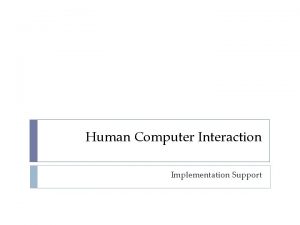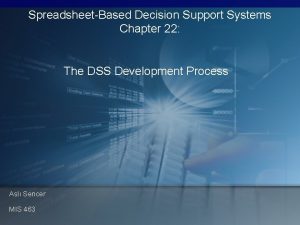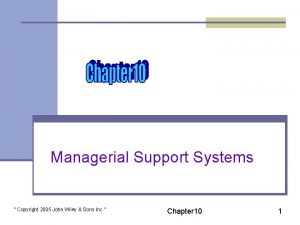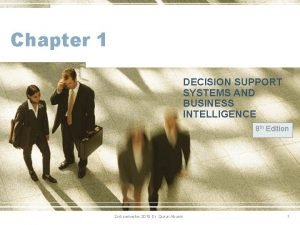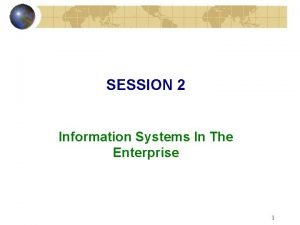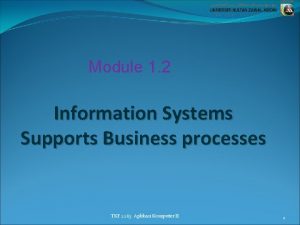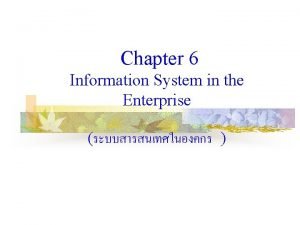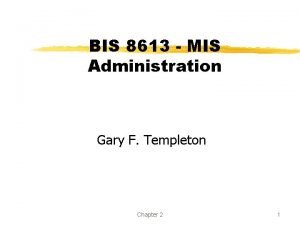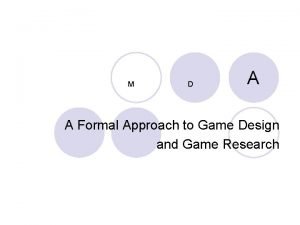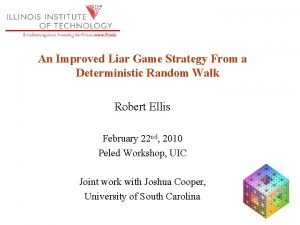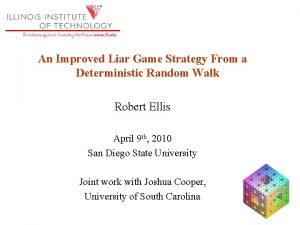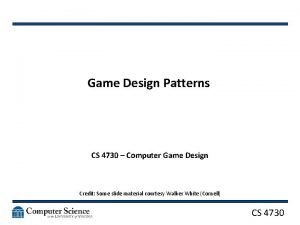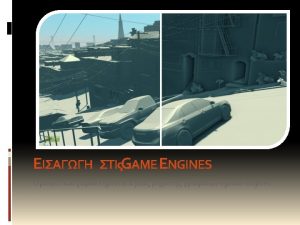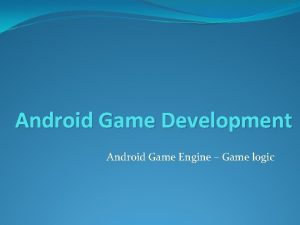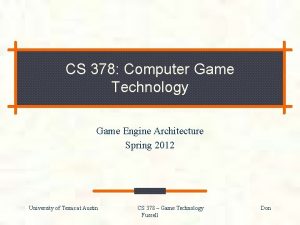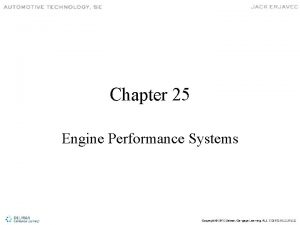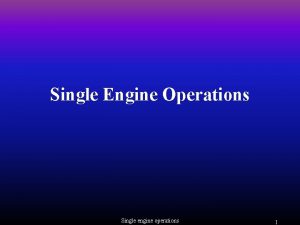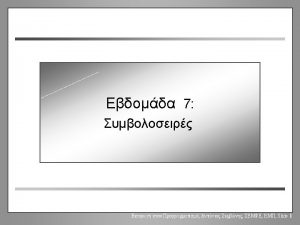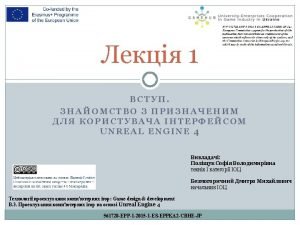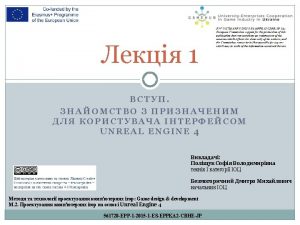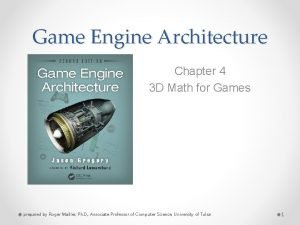Game Engine Architecture Chapter 5 Engine Support Systems

















































- Slides: 49

Game Engine Architecture Chapter 5 Engine Support Systems prepared by Roger Mailler, Ph. D. , Associate Professor of Computer Science, University of Tulsa 1

Overview • • • Subsystem Start-up and shut down Memory Management Containers Strings Engine Configuration prepared by Roger Mailler, Ph. D. , Associate Professor of Computer Science, University of Tulsa 2

Start-up and shut-down • Game engines are complex beasts • When it first starts up a number of subsystems must be configured and initialized • Order is relevant because of subsystem dependencies • Typically started in one direction and shutdown in the opposite prepared by Roger Mailler, Ph. D. , Associate Professor of Computer Science, University of Tulsa 3

Singleton • A common pattern for game engine components is to create managers using a singleton class Render. Manager{ public: Render. Manager (){ //start up the manager } ~Render. Manager (){ //shut down the manager } }; //singleton instance static Render. Manager g. Render. Manager prepared by Roger Mailler, Ph. D. , Associate Professor of Computer Science, University of Tulsa 4

Initialization and singleton • C++ does static object creation just before the main method is called • The order for static object creation is arbitrary • Not very good for controlling the order of startup and shutdown prepared by Roger Mailler, Ph. D. , Associate Professor of Computer Science, University of Tulsa 5

Controlling the singleton • One trick you can use is that a static variable declared within a method is not initialized at startup class Render. Manager{ public: static Render. Manager& get(){ static Render. Manager s. Singleton; return s. Singleton; } Render. Manager (){ Video. Manager: : get(); Texture. Manager: : get(); } ~Render. Manager (){ }; } //shut down the manager • This works pretty well, but you cannot control the shutdown at all prepared by Roger Mailler, Ph. D. , Associate Professor of Computer Science, University of Tulsa 6

Do it directly • Create startup and shutdown methods in all of the managers o It’s simple o It’s understandable o Easy to debug and maintain • You could also use singletons where the main creates the objects using new • Take a look at the code from OGRE and Naughty Dog’s games in the book prepared by Roger Mailler, Ph. D. , Associate Professor of Computer Science, University of Tulsa 7

Memory Management • The performance of your game engine is associated not only with your algorithms, but the way you use memory o malloc() and new are slow o Access pattern and memory fragmentation seriously impact caching performance prepared by Roger Mailler, Ph. D. , Associate Professor of Computer Science, University of Tulsa 8

Dynamic Allocation • Heap allocation is slow because it has to be general o Handles requests from 1 byte to 1 GB o Creates a ton of management overhead • Also slow because of a context switch o First switches from user to kernel mode o Then has to switch back • Cannot completely avoid dynamic allocation, but can create custom allocators to avoid it prepared by Roger Mailler, Ph. D. , Associate Professor of Computer Science, University of Tulsa 9

Stack-based Allocator • The easiest way is to use a pre-allocated memory block and use it as a stack • When a level is loaded, add it to the stack, when it is finished, move the stack pointer back • Order is important because you can overwrite a current used memory location • Often done using rollback markers prepared by Roger Mailler, Ph. D. , Associate Professor of Computer Science, University of Tulsa 10

Stacks prepared by Roger Mailler, Ph. D. , Associate Professor of Computer Science, University of Tulsa 11

Double ended • Another method uses a double ended stack o Useful for having big allocations on one side and small temporary on the other prepared by Roger Mailler, Ph. D. , Associate Professor of Computer Science, University of Tulsa 12

Pool Allocator • This technique works by allocating a large number of fixed sized memory blocks o 1, 000 4 X 4 matrices • When you need a new matrix, you get it from the pool • Return it to the pool when are done • The pool can be managed by a linked list prepared by Roger Mailler, Ph. D. , Associate Professor of Computer Science, University of Tulsa 13

Aligned Allocation • One problem with pooled memory is that every variable and object has an alignment requirement • The memory allocator must be able to return aligned memory otherwise you have serious trouble • Not a serious problem as an aligned allocator is easy to write prepared by Roger Mailler, Ph. D. , Associate Professor of Computer Science, University of Tulsa 14

Single or double frame • You often need to allocate memory every frame One way to do this is to use a single frame buffer • Allocate the memory once and free it only when the rendering is complete o Very fast, you have to be careful • A double frame buffer might be better in a multi-core setup o Allocate memory at frame i for use in i+1 prepared by Roger Mailler, Ph. D. , Associate Professor of Computer Science, University of Tulsa 15

Fragmentation • Doing dynamic allocation can create memory fragments o This slows down memory copies o Can prevent allocation when a contiguous block is not available • Pooled and stack allocators avoid this problem prepared by Roger Mailler, Ph. D. , Associate Professor of Computer Science, University of Tulsa 16

Fragmentation • If you need random allocation/deallocation you may require a defragmentation routine prepared by Roger Mailler, Ph. D. , Associate Professor of Computer Science, University of Tulsa 17

Shift prepared by Roger Mailler, Ph. D. , Associate Professor of Computer Science, University of Tulsa 18

Defrag • The defrag operation can occur over several frames o Just move one thing at a time • Moving memory is tricky though o All pointers to it need to be updated • Handles are frequently used o Handles point to immutable memory that contains the current pointer to the object (yes, a pointer to a pointer) prepared by Roger Mailler, Ph. D. , Associate Professor of Computer Science, University of Tulsa 19

Cache • By now, you should understand how cache works • To avoid cache misses on data, we try to keep data chunks small, contiguous in memory, and access them sequentially • Instructions are also held in cache prepared by Roger Mailler, Ph. D. , Associate Professor of Computer Science, University of Tulsa 20

I-Cache • The compiler and linker handle most of the details about how code is represented in memory • We can help it because it follows certain rules 1. Machine code from a function is contiguous in memory 2. Functions are stored in their original order 3. Functions in a single file are almost always contiguous prepared by Roger Mailler, Ph. D. , Associate Professor of Computer Science, University of Tulsa 21

Taking Advantage • Keep high-performance code small • Avoid making function calls in a performance critical section • If you have to call a function, put it as close as possible to the caller and never in another file • Don’t overuse inline functions, they can bloat the code prepared by Roger Mailler, Ph. D. , Associate Professor of Computer Science, University of Tulsa 22

Containers • Games developers use many different data structures o o o o Array Dynamic Array Linked List Queue Deque Tree Binary Search Tree Binary heap Priority Queue Dictionary Set Graph Directed acyclic graph • Many of these can be found in STL (Standard Template Library) prepared by Roger Mailler, Ph. D. , Associate Professor of Computer Science, University of Tulsa 23

Container Operations • • • Insert Remove Sequential access (iteration) Random access Find Sort • Remember that different containers have different costs for these various operations prepared by Roger Mailler, Ph. D. , Associate Professor of Computer Science, University of Tulsa 24

Iterators • STL has an iterator class that works much like the one in Java • Allows you to maintain encapsulation in the container object • Easier to use than pointer manipulation void process. List (std: : list<int>& container) { std: : list<int>: : iterator p. Begin = container. begin(); std: : list<int>: : iterator p. End = container. end(); std: : list<int>: : iterator p; for (p = p. Begin; p !=p. End; p++) { int element = *p; } } prepared by Roger Mailler, Ph. D. , Associate Professor of Computer Science, University of Tulsa 25

Building Custom Containers Many reasons to do so 1. Total control – you dictate the algorithms, memory use, etc. 2. Opportunities to optimize – optimize based on a specific hardware platform 3. Customizability – can add custom features specific to your purpose 4. Elimination of external dependencies – no licensing fees, you can fix it yourself 5. Control of concurrent data structures – you have total control over concurrent access prepared by Roger Mailler, Ph. D. , Associate Professor of Computer Science, University of Tulsa 26

Standard Template Library • Benefits o Rich set of features o Robust implementation on a wide variety of platforms o Comes standard with most C++ compilers • Drawbacks o o o Steep learning curve Often slower than a custom crafted data structure Eats up a lot of memory Does a lot of dynamic memory allocation Performance varies based on the compiler prepared by Roger Mailler, Ph. D. , Associate Professor of Computer Science, University of Tulsa 27

Rules for using STL • Be aware of the performance and memory characteristics • Avoid heavyweight STL classes in critical code sections • Don’t use it when memory is at a premium • Use STLPort if you plan to create multiplatform games prepared by Roger Mailler, Ph. D. , Associate Professor of Computer Science, University of Tulsa 28

Boost • Aim was to build libraries that extend and work with STL • Benefits o o Provides things not available in STL Provides some workarounds to problems with STL Handles complex problems like smart pointers Documentation is really good • Drawbacks o Most core classes are templates – has large. lib files o No guarantees – if you find a bug, it’s your issue o Boost license – not very restrictive prepared by Roger Mailler, Ph. D. , Associate Professor of Computer Science, University of Tulsa 29

Loki • Written by Andrei Alexandrescu • Very powerful, but hard to understand • Less portable because it uses sophisticated compiler tricks • Look for the book Modern C++ Design by Alexandrescu prepared by Roger Mailler, Ph. D. , Associate Professor of Computer Science, University of Tulsa 30

Strings • Strings are extremely important in games • They are far from simple to manage o What if they need to be resized? o How do you deal with localization issues? • Different character sets • Different lengths for translations • Different display layouts • Checking for equality is an O(n) operation prepared by Roger Mailler, Ph. D. , Associate Professor of Computer Science, University of Tulsa 31

String Classes • They come with an overhead o Copy constructors on a function call o Dynamic memory allocation • Probably should be avoided by using fixed sized wchar_t arrays • Path classes might be the exception o Often include more information than a String prepared by Roger Mailler, Ph. D. , Associate Professor of Computer Science, University of Tulsa 32

Unique IDs • Objects within the game need a way to be identified • Strings seem like a natural choice o Comparison costs are not good • GUIDs (numbers) are a lot faster to compare o Harder to remember prepared by Roger Mailler, Ph. D. , Associate Professor of Computer Science, University of Tulsa 33

Hashed String IDs • We can use hash functions to map our strings to numbers o Best of both worlds • Collisions are possible o A good hash function eliminates this concern o Using an uint 32 for the values gives over 4 million possible values • These are sometimes referred to as a string id prepared by Roger Mailler, Ph. D. , Associate Professor of Computer Science, University of Tulsa 34

Implementation ideas • Runtime hashing can be slow o Doing many of them can take a long time • One way to avoid this is to offline process the source code o Look for occurrences of the function call and replace it with the hashed number • Another way is to create a static variable to intern the string ids prepared by Roger Mailler, Ph. D. , Associate Professor of Computer Science, University of Tulsa 35

Localization • Best to plan for localization from day 1 • Important to understand that ASCII character codes don’t support localization at all • Retrain your brain to think in Unicode prepared by Roger Mailler, Ph. D. , Associate Professor of Computer Science, University of Tulsa 36

Unicode • Like ASCII, unicode assigns a unique code point to every character or glyph • When storing characters we use a particular encoding • The combination of encoding and code point yields a character or glyph • Common encodings are o UTF-32 o UTF-8 o UTF-16 prepared by Roger Mailler, Ph. D. , Associate Professor of Computer Science, University of Tulsa 37

UTF-32 • The simplest encoding because all code points are stored in a 32 -bit value • Wasteful o Most western languages don’t use high value code points (wastes 2 bytes per character) o The highest Unicode point is 0 x 10 FFFF (only 21 bits) • Easy because we can figure out the length of a string by dividing number of bytes by 4 prepared by Roger Mailler, Ph. D. , Associate Professor of Computer Science, University of Tulsa 38

UTF-8 • Code points are stored in one-byte granularity, but some use two • It’s called variable length encoding or multibyte character set (MBCS) • It’s backwards compatible with ANSI encoding o Needs 7 bits to represent the 127 characters • Multibyte characters have the first bit set to one o This indicates that there are two bytes in the code point prepared by Roger Mailler, Ph. D. , Associate Professor of Computer Science, University of Tulsa 39

UTF-16 • • A bit simpler than UTF-8, but more expensive Code points stored as one or two 16 -bit values Also called Wide Character Set (WCS) UTF contains 17 planes that each contain 216 code points • First plane called basic multilingual plane (BMP) o Most characters are present in this plane • The other planes are called supplementary planes o Requires two 16 -bit values prepared by Roger Mailler, Ph. D. , Associate Professor of Computer Science, University of Tulsa 40

UCS-2 • A subset of UTF-16 containing only the BMP • Its main advantage is that it is fixed length o UTF-16 and UTF-8 are variable length • Can be stored in little endian or big endian o Often stored with a Byte Order Marker (BOM) prepared by Roger Mailler, Ph. D. , Associate Professor of Computer Science, University of Tulsa 41

char and wchar_t • Standard C/C++ define two data types for characters o char is used to for legacy ANSI strings or for MBCS o wchar_t is used to represent any valid code point • Could be 8, 16, or 32 bits • To write truly platform independent code you will need to define your own character data types prepared by Roger Mailler, Ph. D. , Associate Professor of Computer Science, University of Tulsa 42

Unicode in Windows • In Windows wchar_t is exclusively for UTF-16 encoding and char for ANSI encoding • Windows API defines three sets of character/string functions ANSI WCS MBCS strcmp() wcscmp() _mbscmp() strcpy() wcscpy() _mbscpy() strlen() wcslen() _mbstrlen() • There also translation functions like wcstombs() prepared by Roger Mailler, Ph. D. , Associate Professor of Computer Science, University of Tulsa 43

Unicode on Consoles • Xbox 360 uses WCS strings • At Naughty Dog they only use char strings o Foreign languages are handled with UTF-8 encoding prepared by Roger Mailler, Ph. D. , Associate Professor of Computer Science, University of Tulsa 44

Other Localization Concerns • Need to translate more than strings o o Audio clips Textures – if they have English words on them Symbols – may not mean what you think it means Market specific game-rating issues – blood changes the teen-rating in Japan • Localization database o Need a way to convert string ids to human readable strings o Form is up to you – Varies from CSV to full databases Id English French p 1 score “Player 1 Score” “Grade Joueur 1” p 2 score “Player 2 Score” “Grade Joueur 2” p 1 wins “Player one wins!” “Joueur un gagne!” p 2 wins “Player two wins!” “Joueur deux gagne!” prepared by Roger Mailler, Ph. D. , Associate Professor of Computer Science, University of Tulsa 45

Final notes • Establish a set of functions early to handle localization • Force developers to use those functions instead of using string literals in the code • Create a configuration system to allow the language to be set prepared by Roger Mailler, Ph. D. , Associate Professor of Computer Science, University of Tulsa 46

Engine Configuration • Most engines require the ability to save and load configuration files • Many ways to do this o o o Text files Compressed binary files Windows registry Command line options Environmental variables Online user profiles prepared by Roger Mailler, Ph. D. , Associate Professor of Computer Science, University of Tulsa 47

Game vs User options • Be careful to separate the game settings from those of a particular user • On windows machines you can use Application. Data directory by creating your own folder • You can also use the special key HKEY_CURRENT_USER in the registry to store settings information prepared by Roger Mailler, Ph. D. , Associate Professor of Computer Science, University of Tulsa 48

Examples • Quake uses Cvars – named values with a set of flags o These are stored in a linked list and the values are retrieved by name o The flags indicate if the value should persist – written to file • Ogre 3 D o Uses text files in the Windows INI format • Uncharted o Several mechanisms including Scheme prepared by Roger Mailler, Ph. D. , Associate Professor of Computer Science, University of Tulsa 49
 Game engine architecture
Game engine architecture Game engine architecture
Game engine architecture Decision support systems and intelligent systems
Decision support systems and intelligent systems Chapter 30 engine starting systems
Chapter 30 engine starting systems External and internal combustion engine
External and internal combustion engine Engine support system
Engine support system Grammatical signals examples
Grammatical signals examples Sustainable and green engines
Sustainable and green engines Ogre game engine tutorial
Ogre game engine tutorial Rts game engine
Rts game engine Acid game engine
Acid game engine Gii game engine
Gii game engine Unreal engine game loop
Unreal engine game loop Core game engine
Core game engine Renderware engine tutorial
Renderware engine tutorial Torque game engine
Torque game engine Flame game engine
Flame game engine Information retrieval architecture
Information retrieval architecture Order matching engine architecture
Order matching engine architecture Term-document incidence matrix
Term-document incidence matrix Search engine architecture
Search engine architecture Promotion engine as a service
Promotion engine as a service Cell broadband engine architecture
Cell broadband engine architecture Search engine architecture
Search engine architecture What is implementation support in hci
What is implementation support in hci What are the 5 engine systems?
What are the 5 engine systems? Swagelok mechanical seal support systems
Swagelok mechanical seal support systems Decision support and business intelligence systems
Decision support and business intelligence systems Developing spreadsheet-based decision support systems
Developing spreadsheet-based decision support systems What is a management support system
What is a management support system Heta desai
Heta desai Eolss
Eolss Managerial support systems
Managerial support systems Decision support system in business intelligence
Decision support system in business intelligence Executive support systems
Executive support systems An example of a cross-functional business process is
An example of a cross-functional business process is Types of decision making in management
Types of decision making in management World oldest tree using
World oldest tree using Executive support systems
Executive support systems Expert system in dss
Expert system in dss Executive support systems
Executive support systems Professional support system
Professional support system Btec business unit 5 international business assignment 1
Btec business unit 5 international business assignment 1 Pirate game theory
Pirate game theory The farming game instructions
The farming game instructions A formal approach to game design and game research
A formal approach to game design and game research Game lab game theory
Game lab game theory Liar game game theory
Liar game game theory Liar game game theory
Liar game game theory Game architecture patterns
Game architecture patterns

